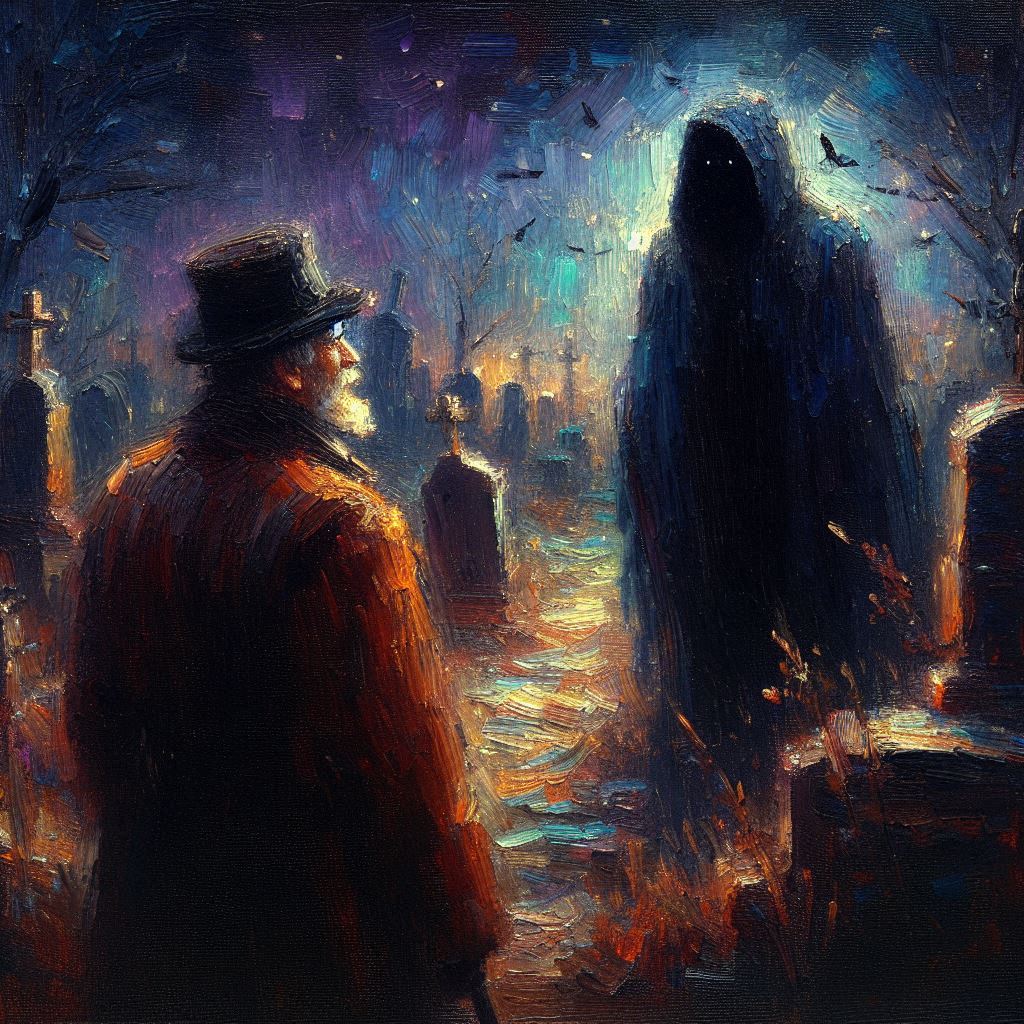October 21, 2024
Death in A Christmas Carol: The Impossible Representation
It’s been a while since I shared something from my academic vault of uselessness… Well, alright; knowledge and thought are never useless; academia (the way it’s run nowadays) might be. But I digress. The following post on death in A Christmas Carol is a modified excerpt (pp. 148-149) from my doctoral dissertation, “Time is Everything with Him”: The Concept of the Eternal Now in Nineteenth-Century Gothic, which can be downloaded (for free) from the repository of the Tampere University Press.
Also take a look at my posts on religion in A Christmas Carol and, especially, Gothic Immortality in Dickens’s work – the present post forms a nice pair with the latter.

Death in A Christmas Carol Comes Quasi-Announced
Not surprisingly, it is the third Ghost, that of Christmas Yet to Come, which conveys the greatest sense of awe. The mysterious figure filling Scrooge with “a solemn dread” was “tall and stately”, and wore “a deep black garment, which concealed its head, its face, its form, and left nothing of it visible save one outstretched hand” (CC 58).
Scrooge would have not been able to separate the spirit from the enveloping darkness without this detail, an element that is telling of the relation between the third spirit and representation (or lack thereof). For Scrooge, the third spirit is tautological with the formless dark surroundings, identical with the “Invisible World”.
By that point, Scrooge is able to realize another sublime attribute of the third spirit. Besides inspiring “solemn dread” and awe, and eluding representation, the Ghost of Christmas Yet to Come also offers a glimpse at what might exist beyond the threshold.
Scrooge is explicit on this matter: Filled with “a vague uncertain horror”, he tells the Ghost that he fears it more than the others, but he is ready to be guided onwards, hoping “to live to be another man” (CC 58). To reach this hope, however, Scrooge must encounter the ultimate Gothic sublime, death itself.
The Ultimate Unrepresentable
Like the spirits before, the third spirit transports Scrooge to an alternative space-time. The old man realizes it is the future, although he struggles to make sense of it, feeling confused he cannot find his own self, his own instance in this alternative universe:
He looked about in that very place for his own image; but another man stood in his accustomed corner, and though the clock pointed to his usual time of day for being there, he saw no likeness of himself among the multitudes that poured in through the Porch.
(CC 60)
For Scrooge, it is unthinkable to visualize the future without his own self in it. This reaches a breaking point when the Ghost shows Scrooge a grave. The old man begins to realize what is happening, and he is too frightened to proceed. Before he looks at the tombstone, he demands that the spirit answers a question: “Are these the shadows of the things that Will be, or are they shadows of things that May be, only?” (CC 70).
The dark, ever-silent figure remains immobile and continues to point at the grave. Scrooge insists and, at the verge of panic, tries to reassure himself: “Men’s courses will foreshadow certain ends, to which, if persevered in, they must lead … But if the courses be departed from, the ends will change” (CC 70). In the end, he musters up the courage to read the tombstone, discovering his own name. The realization of his own death is beyond his capacity to conceptualize, and he cries: “Am I that man who lay upon the bed?” (CC 70; emphasis in the original).
Scrooge’s emphatic way of pronouncing “I”, as the italics in the text reveal, is characteristic of a man unable to grasp his own annihilation. The Gothic sublime finds an apt embodiment in this scene. Scrooge cannot stand to see his own demise and face his mortality, much like Dracula, who cannot see himself in the mirror and thus face his immortality.
Death becomes “the always recurring/repeating presence that threatens the subject with the image of his or her own impossible representation” (Mishra 1994, 79). Scrooge, seeking to alter this impossible representation, becomes a synecdoche for the Gothic representation of reality in general: omnijective and synthetic, it becomes the sublime sense of something that, although essentially unrepresentable, is metaphysically felt to exist.
Death in A Christmas Carol: Works Cited
Dickens, Charles. A Christmas Carol. London: Penguin Books, 1994 (cited as CC).
Mishra, Vijay. The Gothic Sublime. Albany: State University of New York Press,
1994.
I don't show you ads, newsletter pop-ups, or buttons for disgusting social media; everything is offered for free. Wanna help support a human internet?
(If you'd like to see what exactly you're supporting, read my creative manifesto).
